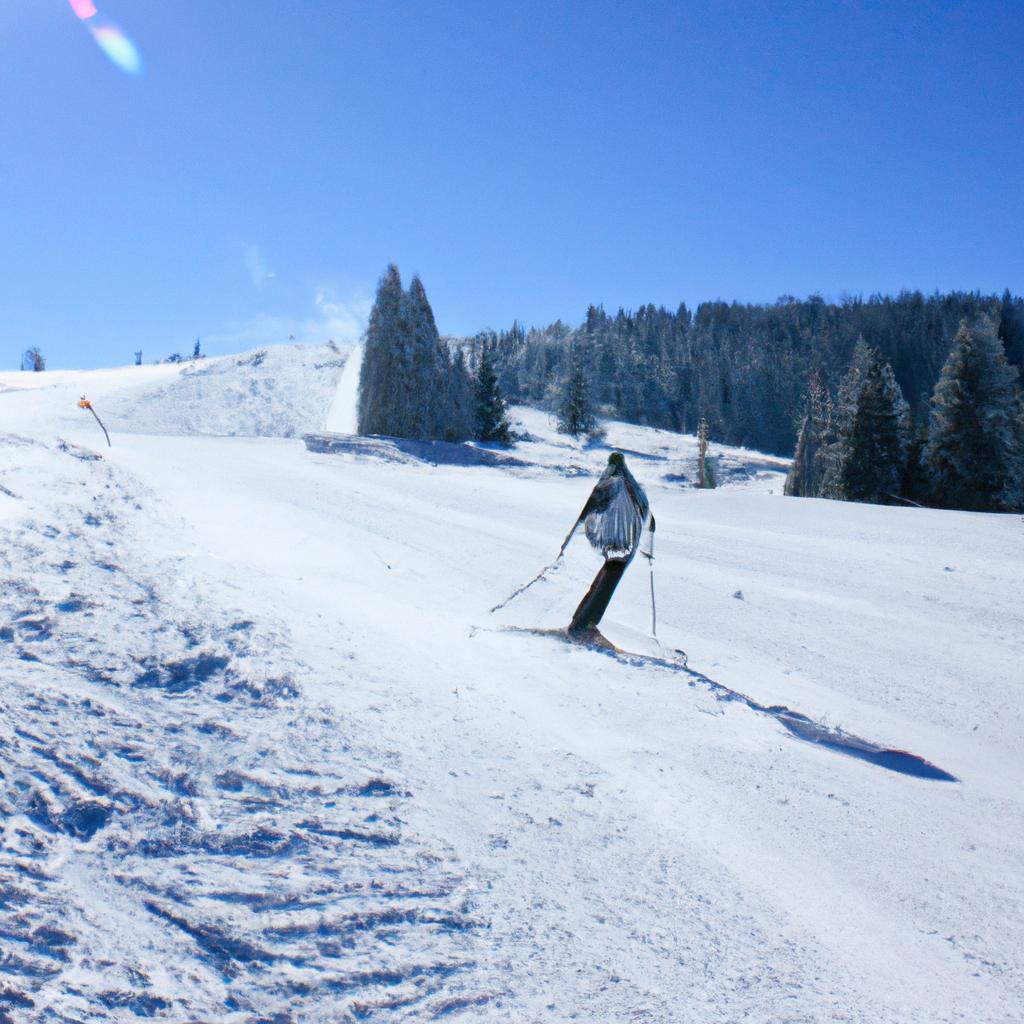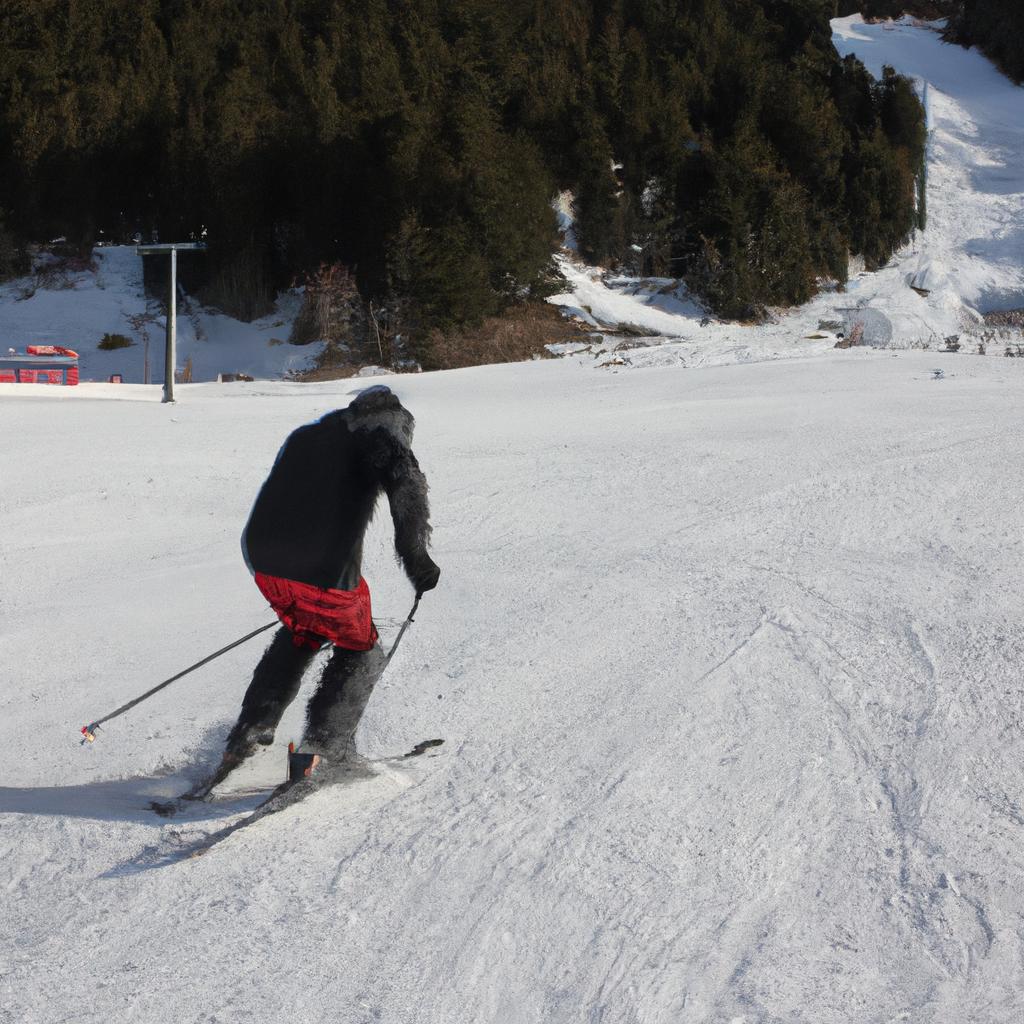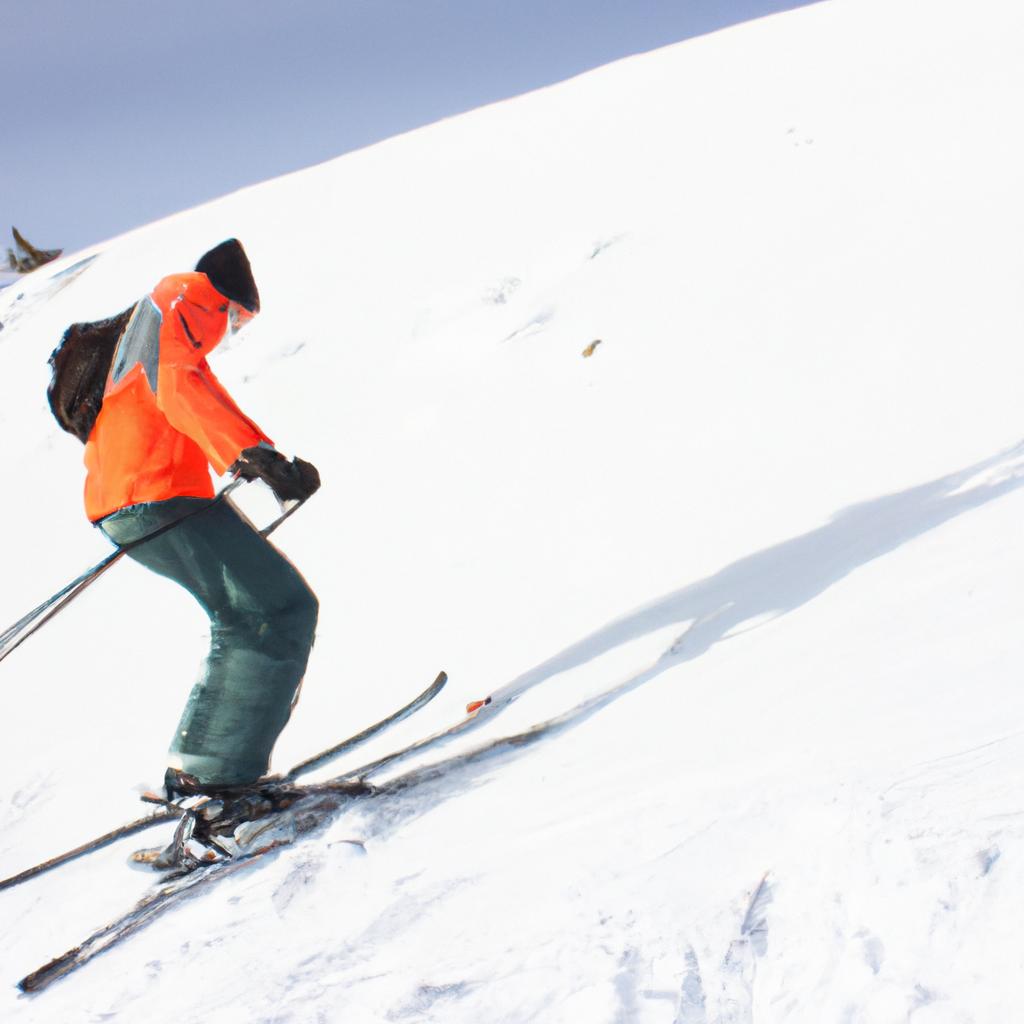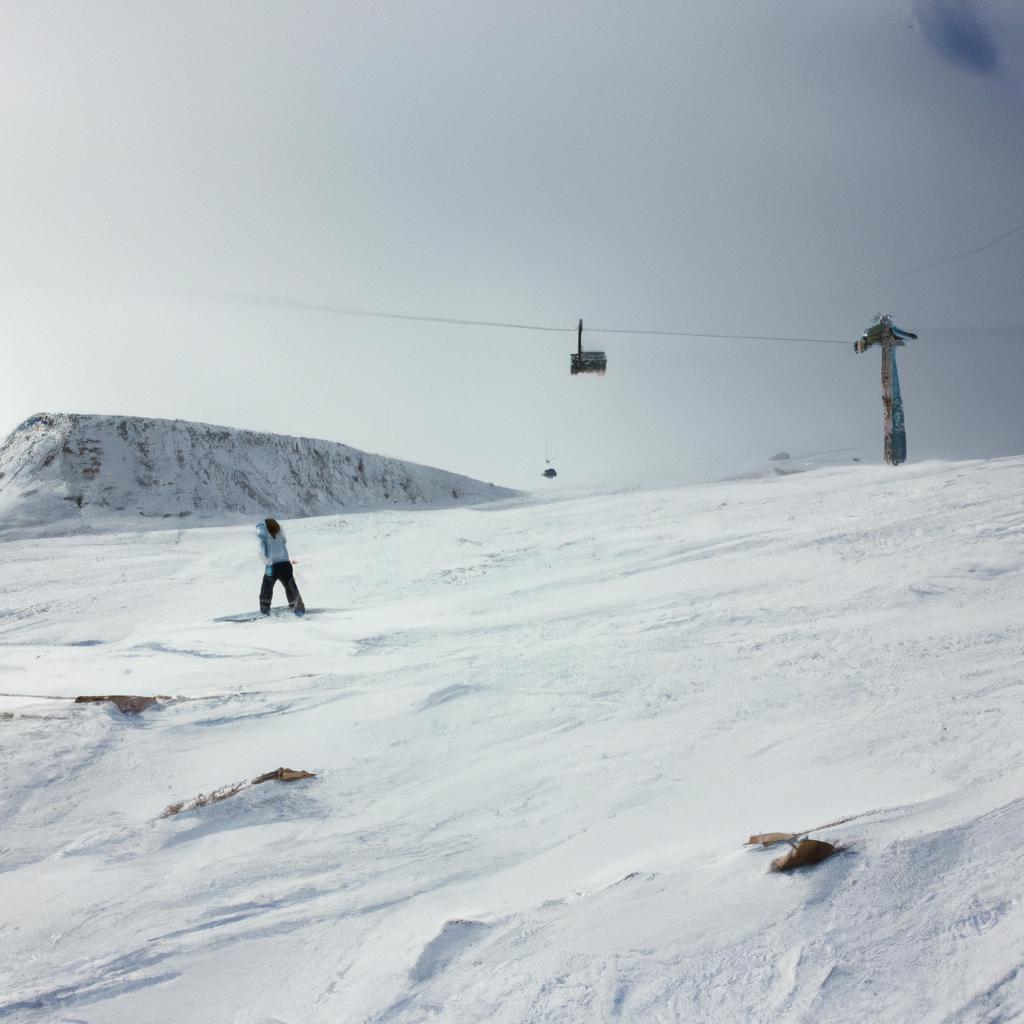Freestyle skiing, a dynamic and exhilarating winter sport, has gained immense popularity among adrenaline-seeking enthusiasts around the world. This article serves as an ultimate guide to mastering the art of shredding the slopes through freestyle skiing techniques and strategies. To illustrate the allure and challenges of this discipline, consider the hypothetical case study of Alex, a beginner skier who embarks on a journey to conquer freestyle skiing.
Alex’s journey begins with understanding the fundamental elements that define freestyle skiing. Unlike traditional alpine or cross-country skiing, freestyle skiing encompasses various tricks and maneuvers performed on different terrains such as moguls, jumps, rails, and halfpipes. It demands not only exceptional technical skills but also creativity and fearlessness in executing aerial stunts while maintaining control over one’s body movements. By delving into this comprehensive guide, aspiring freestylers like Alex can unlock their potential by learning from experienced professionals’ insights and perfecting each aspect of their technique. Whether it is carving smooth lines down steep slopes or launching off massive kickers high above ground level, this article aims to equip readers with essential knowledge to excel in all aspects of freestyle skiing.
In subsequent sections, we will delve into critical areas such as equipment selection, proper stance and body position, mastering basic jumps and tricks, and progressing to advanced maneuvers. To begin, let’s discuss equipment selection.
When it comes to freestyle skiing, having the right equipment is crucial for both performance and safety. Here are some key considerations:
-
Skis: Opt for twin-tip skis specifically designed for freestyle skiing. These skis have tips and tails that curve upward, allowing for easy maneuverability in both forward and backward directions. Look for skis with a medium flex to provide stability while landing jumps.
-
Bindings: Choose bindings that offer reliable release mechanisms to protect your knees during falls or crashes. Adjustable bindings can be advantageous as they allow you to fine-tune the ski’s mounting position based on your preferences.
-
Boots: Freestyle boots should provide a good balance between flexibility and support. They need to be comfortable enough to allow freedom of movement while providing adequate ankle support.
-
Helmet: Safety should always be a priority in any sport, especially freestyle skiing where the risk of falls is higher. Invest in a well-fitting helmet that meets safety standards and protects your head from impacts.
-
Clothing: Dress appropriately for the weather conditions on the slopes. Layering is key, so you can adjust your clothing according to temperature changes throughout the day. Don’t forget waterproof pants and jackets to keep yourself dry.
Once you have selected suitable equipment, the next step is understanding proper stance and body position in freestyle skiing.
Maintaining a balanced stance is essential for executing tricks effectively and ensuring stability while skiing. Here are some guidelines:
-
Centered Balance: Keep your weight centered over your skis by distributing it evenly between both feet. Avoid leaning too far back or forward as it can disrupt control.
-
Bent Knees: Maintain a slight bend in your knees at all times to absorb shocks when landing jumps or navigating rough terrains like moguls.
-
Forward Lean: Lean slightly forward from your hips to maintain a strong and athletic position. This posture helps with control and balance.
-
Arms and Hands: Keep your arms relaxed and slightly forward, allowing them to move freely for balance adjustments. Avoid letting them swing too wildly as it may throw off your stability.
Mastering the basics of jumps and tricks is a crucial step in progressing as a freestyle skier. Start with these fundamental techniques:
-
Ollie: The ollie is the foundation for many tricks in freestyle skiing. It involves using both legs to push off the ground while bending your knees and then extending them explosively to lift yourself into the air.
-
Grabs: Once you’re comfortable with ollies, start incorporating grabs into your jumps. Grabs involve reaching down and grabbing a part of your ski or binding mid-air, adding style to your tricks.
-
180s: Begin by practicing 180-degree spins on flat terrain before attempting them off jumps or rails. Use your core muscles to initiate the spin while maintaining control over both skis.
-
Boxes and Rails: Progress to riding boxes and rails once you have developed confidence in basic jumps. Start with straight approaches initially, gradually advancing to more complex angles and combinations.
As you gain proficiency in these basic techniques, you can advance to more advanced maneuvers such as flips, spins with multiple rotations, and complex rail slides.
Remember that freestyle skiing requires practice, patience, and perseverance. Always prioritize safety by wearing protective gear and gradually progressing at your own pace. Seek guidance from experienced skiers or consider taking lessons from certified instructors who can provide valuable feedback on technique improvement.
With dedication, determination, and this comprehensive guide at hand, Alex’s journey into freestyle skiing will undoubtedly be an exhilarating one filled with growth as he conquers new challenges on the slopes!
Gear up: Essential equipment for freestyle skiing
Imagine this scenario: You’re standing at the top of a snow-covered mountain, ready to embark on an exhilarating journey down the slopes. As you prepare to make your way through twists and turns, jumps and tricks, having the right gear becomes crucial for both safety and performance. In this section, we will explore the essential equipment needed for freestyle skiing.
To fully enjoy the thrill of freestyle skiing, it is imperative to invest in high-quality ski boots that provide comfort and support. These boots should fit snugly without causing any pain or discomfort during long hours on the slopes. Additionally, look for boots with a flex rating that matches your skill level – beginners typically benefit from softer flex while more advanced skiers may prefer stiffer options.
Next on our list is choosing appropriate skis. Freestyle skis are specifically designed to enhance maneuverability and allow skiers to perform aerial tricks effortlessly. Typically shorter than traditional alpine skis, they offer greater control when executing spins and flips. Look out for twin-tip skis which have curved upwards tails – these enable easier backwards skiing as well as landing switch after performing jumps.
Protective gear plays a vital role in ensuring your safety while engaging in high-risk activities like freestyle skiing. A helmet is perhaps the most important piece of protective equipment you can invest in. It safeguards against head injuries during falls or collisions. Other essentials include goggles to shield your eyes from wind, sun glare, and potential debris; wrist guards to prevent fractures in case of hard landings or crashes; and knee pads for added protection during jumps and maneuvers.
As you suit up with all necessary gear before hitting the slopes, keep in mind that safety should always be prioritized alongside fun and excitement. Remembering to check off each item on your checklist ensures not only a thrilling experience but also minimizes risks associated with extreme sports.
Transitioning into the next section, “Mastering the basics: A tutorial for beginners,” it is crucial to familiarize yourself with your gear before venturing into freestyle skiing. By understanding how each piece of equipment functions and affects your performance, you will be better prepared to tackle the challenges that lie ahead. So buckle up and get ready to delve into the fundamental techniques of this thrilling sport.
Mastering the basics: A step-by-step tutorial for beginners
Having explored the essential equipment required for freestyle skiing, it is now time to delve into the step-by-step process of mastering the basics. By following these fundamental techniques, beginners can gain a solid foundation in freestyle skiing and pave their way towards becoming proficient on the slopes.
Paragraph 1:
To begin your journey as a freestyle skier, it is crucial to focus on balance and body positioning. Imagine yourself standing at the top of a slope, feeling the crisp mountain air against your face as you prepare to make your descent. As you push off with one ski and glide down the hill, maintain an athletic stance with slightly bent knees and ankles. This position provides stability and control over your movements, allowing you to navigate turns smoothly. Throughout your descent, ensure that your upper body remains relaxed yet engaged, providing stability while also enabling fluid motion.
Paragraph 2:
In addition to maintaining proper posture, understanding how weight distribution affects your skiing technique is vital. When initiating turns or tricks, shifting your weight appropriately plays a significant role in executing precise maneuvers. For instance, when making sharp turns around obstacles or performing jumps, distributing more weight onto one ski facilitates better edge control and maneuverability. Conversely, evenly distributing weight between both skis enhances stability during straight-line descents or landings after aerial stunts.
Emphasizing these four key points will help beginner freestyle skiers progress quickly:
- Practice regularly: Consistency is key in improving any skill; dedicating regular practice sessions will enhance muscle memory and overall proficiency.
- Seek professional guidance: Enlisting the expertise of trained instructors will provide valuable insights into correct form and technique.
- Start small and progress gradually: Begin with simple tricks before advancing to more complex ones; this approach ensures safety while building confidence.
- Stay motivated: Freestyle skiing requires patience and perseverance; staying motivated through challenges will lead to personal growth and achievement.
Table – The Four Key Points:
| Key Point | Description |
|---|---|
| Practice regularly | Consistency in practice sessions improves muscle memory and overall proficiency. |
| Seek professional guidance | Trained instructors provide valuable insights into correct form and technique. |
| Start small and progress gradually | Beginning with simple tricks promotes safety while building confidence; gradual advancement leads to skill development. |
| Stay motivated | Patience and perseverance are crucial; maintaining motivation through challenges fosters personal growth and achievement on the slopes. |
Paragraph 3:
By focusing on balance, body positioning, weight distribution, and following these key points, beginners can steadily progress in freestyle skiing. As you become more comfortable with the basics, your curiosity may lead you to explore the thrilling world of freestyle maneuvers. In the next section, we will delve into various tricks and jumps that elevate freestyle skiing to new heights, allowing you to embrace the exhilaration of defying gravity while soaring through the air.
With a solid foundation in place, it’s time to venture into the realm of freestyle maneuvers, where skiers push their limits by executing jaw-dropping tricks and breathtaking jumps. Discovering this exciting aspect of freestyle skiing opens up a whole new dimension for enthusiasts seeking an adrenaline-fueled experience on the slopes.
[Next Section: Tricks and jumps: Exploring the thrilling world of freestyle maneuvers]Tricks and jumps: Exploring the thrilling world of freestyle maneuvers
Section H2: Tricks and jumps: Exploring the thrilling world of freestyle maneuvers
Imagine you are standing at the top of a towering jump, adrenaline coursing through your veins. You take off, soaring high into the air, executing a flawless backflip before landing with precision. This is just one example of the exhilarating tricks and jumps that make up the thrilling world of freestyle skiing.
Freestyle skiing has evolved from its early beginnings in the 1930s to become a popular sport worldwide. With its emphasis on creativity, style, and technical skill, it offers endless possibilities for skiers looking to push their limits on the slopes. Whether you’re a seasoned pro or new to freestyle skiing, there’s always something exciting to learn and discover.
In this section, we will delve deeper into the intricacies of freestyle maneuvers. Here are some key aspects to consider:
-
Trick progression: Freestyle skiing is all about building upon foundational skills and gradually adding complexity to your repertoire. Start with basic grabs and spins before moving on to more advanced tricks like flips and inverted aerials.
-
Terrain park features: The terrain park is where freestyle skiers showcase their skills, utilizing various obstacles such as rails, boxes, and jumps. Understanding how each feature works and practicing proper technique is crucial for performing tricks safely.
-
Style and expression: While mastering technical maneuvers is important, freestyle skiing also allows individuals to express their unique style on the mountain. Experiment with different grabs, rotations, and body movements to develop your own signature moves.
-
Safety precautions: As with any extreme sport, safety should be paramount when engaging in freestyle skiing. Always wear appropriate protective gear such as helmets and padding. Additionally, familiarize yourself with park etiquette and know your limits to minimize the risk of accidents or injuries.
Table: Notable Freestyle Skiing Competitions
| Competition | Location | Annual Date | Discipline(s) |
|---|---|---|---|
| Winter X Games | Aspen, Colorado | January | Slopestyle, Big Air |
| FIS Freestyle World Cup | Various Locations | Throughout the year | Moguls, Aerials, Halfpipe |
| Dew Tour | Breckenridge, Colorado | December | Slopestyle, Superpipe |
This section has explored the thrilling world of freestyle maneuvers in freestyle skiing. From trick progression to terrain park features and individual style expression, there is a wealth of excitement waiting for those who dare to take on this exhilarating sport. However, it’s essential to prioritize safety while pushing your limits on the slopes.
Safety first: Tips for preventing and dealing with common injuries
Tricks and jumps are undoubtedly the heart of freestyle skiing, offering an exhilarating experience for both skiers and spectators alike. As we delve into this thrilling world of maneuvers, let’s take a moment to explore one example that showcases the skill and creativity involved in freestyle skiing.
Imagine a daring freestyler launching off a massive jump, soaring high above the snowy slopes before executing a flawless backflip with precise control. This display of aerial mastery not only requires immense physical strength but also mental focus and calculated risk-taking. It exemplifies the essence of freestyle skiing – pushing boundaries, defying gravity, and leaving audiences awestruck.
To fully grasp these awe-inspiring tricks and jumps, it is essential to understand the key techniques behind them. Here are some crucial aspects to consider:
- Takeoff: Skiers must approach each jump with confidence, maintaining proper speed and balance while preparing for liftoff.
- Airborne maneuvers: Once airborne, skilled athletes execute various spins, flips, grabs, or combinations thereof to showcase their artistry and individual style.
- Landing: The landing phase demands exceptional agility as skiers must absorb impact smoothly without losing stability or momentum.
- Risk management: Athletes constantly evaluate risks associated with each maneuver they perform; understanding one’s limits can help prevent injuries while still allowing for personal growth.
- Excitement: Witnessing breathtaking stunts creates an adrenaline rush like no other.
- Inspiration: Freestyle skiing inspires individuals to push their own limits and pursue excellence in their chosen endeavors.
- Awe: Observing incredible displays of athleticism leaves people amazed at what human beings are capable of achieving.
- Joy: Participating in freestyle skiing can bring immense joy as individuals conquer challenges and experience pure freedom on the slopes.
Additionally, here is a table outlining different types of freestyle maneuvers, adding further depth to the discussion:
| Trick | Description |
|---|---|
| 360 Spin | A full rotation in mid-air |
| Corkscrew | Multiple spins with a sideways twist |
| Misty Flip | A backflip combined with a sideways spin |
| Rodeo 540 | A high-flying flip with an added 180-degree twist |
As we conclude this section on tricks and jumps, let’s turn our attention to the importance of safety. By understanding how to prevent and handle common injuries associated with freestyle skiing, participants can continue enjoying this exhilarating sport without unnecessary risks.
With a solid foundation in freestyle maneuvers established, it is time to explore strategies for improving speed and technique in order to nail that perfect run.
Nailing the perfect run: Strategies for improving speed and technique
Imagine yourself standing at the top of a steep slope, ready to launch into the air with style and precision. Freestyle skiing is all about pushing your limits and mastering jaw-dropping tricks and jumps that will leave spectators in awe. In this section, we will delve into the techniques required to execute these maneuvers flawlessly, ensuring you become a true master of freestyle skiing.
To kick things off, let’s consider an example scenario. Meet Sarah, an aspiring freestyle skier who dreams of nailing her first 360-degree spin. As she approaches the jump, she must focus on several key elements:
- Approach Speed: Maintaining an appropriate speed is crucial for executing tricks successfully. Too slow, and there won’t be enough momentum; too fast, it becomes difficult to control movements mid-air.
- Takeoff Position: A proper takeoff sets the foundation for a smooth trick execution. Sarah needs to crouch down slightly before launching herself into the air while maintaining balance and keeping her weight centered.
- Body Control: While airborne, body control plays a vital role in completing tricks accurately. By focusing on core strength and stability, Sarah can adjust her body position effectively to achieve various rotations or flips.
- Landing Technique: The landing phase determines how well executed a trick appears overall – sticking it clean demonstrates mastery. Sarah should aim to absorb impact by bending her knees upon touchdown smoothly.
Now that we have explored some essential aspects of performing tricks and jumps in freestyle skiing let’s examine them further using bullet points:
- Approach Speed
- Maintain consistent speed throughout approach
- Adapt speed according to terrain conditions
- Gradually increase speed as confidence grows
- Practice controlled deceleration techniques
Let’s also visualize these factors through the following table:
| Factors | Importance |
|---|---|
| Approach Speed | High |
| Takeoff Position | Medium |
| Body Control | Very High |
| Landing Technique | High |
By considering these crucial elements and practicing diligently, freestyle skiers can progressively hone their skills. With each successful trick mastered, confidence builds, paving the way for even more challenging maneuvers.
Transitioning to the next section about “Taking it to the next level: Competing in freestyle skiing events,” let’s now explore how you can showcase your expertise on a larger stage. It’s time to put all that hard work and dedication into action, as we delve into the world of competitive freestyle skiing.
Taking it to the next level: Competing in freestyle skiing events
Building upon your improved speed and technique, it’s time to take your freestyle skiing skills to a whole new level by entering into competitive events. Whether you’re an aspiring athlete or simply looking for a thrilling experience, competing in freestyle skiing events offers an opportunity to showcase your abilities on a larger stage.
Competing in these events requires not only physical prowess but also mental preparation and strategic planning. Let’s explore some key aspects to consider when taking part in freestyle skiing competitions:
-
Choosing the Right Event: The first step towards competing is finding the right event that aligns with your skill level and interests. From slopestyle to halfpipe, each discipline offers its unique challenges and rewards. Consider what aspect of freestyle skiing excites you the most and choose accordingly.
-
Training Regimen: To enhance your chances of success, developing a comprehensive training regimen becomes imperative. This includes honing specific tricks, perfecting landings, improving flexibility and strength through regular exercises, as well as working on conditioning to endure long hours of practice sessions.
-
Understanding Judging Criteria: Familiarize yourself with the judging criteria used in different freestyle skiing events. Each competition has its own set of rules and scoring system based on factors such as difficulty, execution, amplitude, and style. Understanding how judges evaluate performances will help you tailor your routines accordingly.
-
Mental Preparation: Competitive skiing can be mentally demanding due to the pressure of performing under scrutiny. Developing mental resilience through techniques like visualization, positive self-talk, and focusing on one trick at a time can significantly improve your performance during high-pressure situations.
In addition to these considerations, let’s take a look at a hypothetical case study highlighting how someone progressed from recreational skier to successful competitor:
| Name | Age | Discipline | Journey |
|---|---|---|---|
| Megan Thompson | 23 | Slopestyle | Megan started as a recreational skier but discovered her passion for freestyle skiing. She began practicing tricks on local slopes and eventually gained the confidence to enter small-scale competitions. Through consistent training and perseverance, she progressed to larger events and earned recognition within the freestyle skiing community. Her dedication paid off when she secured sponsorship deals and invitations to prestigious international tournaments. |
Competing in freestyle skiing events offers an exhilarating opportunity to push your limits, gain exposure, and potentially achieve new heights in this sport. By strategically selecting events, dedicating time to training, understanding judging criteria, and preparing mentally, you can embark on a rewarding journey towards becoming a successful competitor.
Remember, success may not come overnight, but with determination and continuous improvement of your skills, you have the potential to make remarkable strides in the world of competitive freestyle skiing.
 Buzzez
Buzzez



